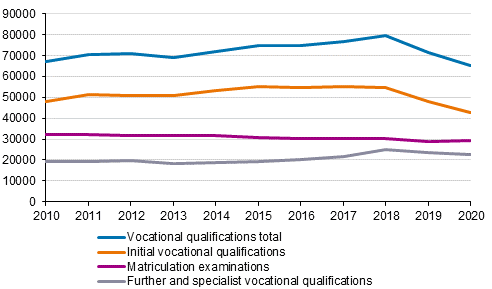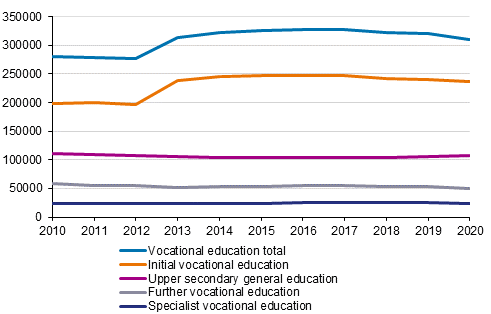Published: 10 June 2021
Number of attainers of vocational qualifications decreased further, number of new passers of the matriculation examination unchanged
According to Statistics Finland’s
education statistics, a total of 107,000 students attended upper
secondary general school education leading to a qualification and
314,000 students were in vocational education leading to a
qualification in 2020.
The number of matriculation examinations completed was 29,000,
which is nearly 300 more than in the previous year. A total of
65,000 vocational qualifications were completed, which is nearly
7,000 fewer than in the year before.
Attainers of matriculation examination and vocational qualifications in 2010 to 2020

Altogether 107,000 students in upper secondary general school education
The number of students in upper secondary general school education leading to a qualification was 107,000 and the number of passers of the matriculation examination was 29,000. Fifty-eight per cent of the students and passers of the matriculation examination were women. There were nearly 38,000 new students in upper secondary general school education. The number of new students remained unchanged from the year before.
Upper secondary general education was provided in 382 educational institutions, 335 of which were upper secondary general schools. Education in Swedish was offered in 36 upper secondary schools and six per cent of the students in upper secondary general school education studied at these schools. Of all students, 2,064 studied for an international matriculation examination. The International Baccalaureate examination was passed by 488 students in 17 upper secondary schools, the European Baccalaureate examination by 12 students at the European School of Helsinki, and the DIA qualification by 35 students in the Helsingin saksalainen koulu (the German School of Helsinki). Eight per cent studied according to the curriculum of upper secondary schools for adults. Ninety-eight per cent of students in upper secondary general schools were under the age of 25.
From 2011 to 2020, the number of educational institutions providing upper secondary general school education has fallen by 51. Over the same period, the number of students in upper secondary general school has diminished by two per cent. The number of matriculation examinations has gone down by nine per cent in ten years. Throughout the 2000s, over one-half of the students and passers of the matriculation examination have been women.
Students in vocational education numbered 314,000, number of new students increased
The number of students in vocational education was 314,000, of whom 51 per cent were women. Of the students in vocational education, 238,000 studied in initial vocational education, 52,000 in further vocational education and 24,000 in specialist vocational education.
Students in upper secondary general education and vocational education in 2010 to 2020*

* The data are from the calendar year, except for those on initial vocational education, which describe the situation on 20 September for the years 2010 to 2012.
New students in vocational education numbered 128,000. The number of new students went up by three per cent. Of the new students, 90,000 studied in initial vocational education, 27,000 in further vocational education and 11,000 in specialist vocational education. In all, nearly 3,000 more new students than one year earlier began studies in initial vocational education. Sixty fewer students began studying for a further vocational qualification, while 700 more students began studying for a specialist vocational qualification than one year previously.
At the autumn cross-sectional period on 20 September, a total of 168,000 students attended initial vocational education leading to a qualification. The number of students in the cross-sectional period is comparable starting from 2019. From 2019 onwards, the data for the cross-sectional period on 20 September include all students in initial vocational education irrespective of the way in which the education is performed.
The variation in the shares of men and women in vocational education viewed by fields of education was large. Of all students the share of women was 85 per cent in the field of health and welfare and 13 per cent in the field of information and communication technologies (ICT). The field of education divided most evenly by gender was the field of services, where 53 per cent were women.
Of the new students, 25 per cent studied in the field of engineering, manufacturing and construction and 22 per cent in the field of services. In both the fields of business and administration, and health and welfare, 19 per cent of new students were studying in each.
Altogether, 65,000 students completed a vocational qualification in 2020. A total of 43,000 initial vocational qualifications were completed, 15,000 further vocational qualifications and 7,000 specialist vocational qualifications. The number of attainers of qualifications was 9 per cent lower than in the previous year. A total of 5,000 fewer initial vocational qualifications were completed than in the previous year. The number of further vocational qualifications attained was 600 lower and that of specialist vocational qualifications 700 lower than in the previous year. Fifty-five per cent of those having completed a qualification were women. The number of qualifications completed was highest, 24 per cent, in the field of engineering, manufacturing and construction. Twenty-three per cent of the qualifications were completed in the field of business and administration and 20 per cent in the field of health and welfare.
Altogether 90 per cent of the students in vocational education attended education according to the reform of vocational education (Vocational Education and Training Act 531/2017) (See Appendix table 2.). If the completion of a qualification was started before the new criteria entered into force (1 August 2018), the qualification can be completed according to the old criteria until 31 December 2021
Of all students, 17 per cent had completed apprenticeship training periods and 13 per cent training agreement periods. Both training agreement and apprenticeship training periods had been completed by one per cent of students.
Twenty-six per cent of the qualifiers had apprenticeship training periods. Sixteen per cent of those with qualifications had training agreement periods. One per cent had both apprenticeship training and training agreement periods. .
Nearly 13,000 students in instruction preparing for and preparatory education for upper secondary education
In all, 400 students participated in preparatory studies for general upper secondary school (LUVA) and good 100 completed the education.
In all, 11,000 students participated in preparatory education for vocational training (VALMA) and 3,000 completed the education. In all, 1,700 students participated in preparatory education for working life and independent living (TELMA) and 400 completed it.
More detailed data on students in upper secondary general education, vocational education and completers of qualifications, and participants in guidance and preparatory education by region of education and age can be found separately in the database tables of upper secondary general education and in the database tables of vocational education. The data are mainly based on the Finnish National Agency for Education's Koski database.
Source: Education. Statistics Finland
Inquiries: Helena Aaltonen 029 551 2697, koulutustilastot@stat.fi
Head of Department in charge: Hannele Orjala
Publication in pdf-format (230.3 kB)
- Tables
-
Tables in databases
Pick the data you need into tables, view the data as graphs, or download the data for your use.
Appendix tables
Updated 10.6.2021
Official Statistics of Finland (OSF):
Students and qualifications [e-publication].
ISSN=2737-0410. Upper secondary general school education and vocational education 2020. Helsinki: Statistics Finland [referred: 18.1.2026].
Access method: http://stat.fi/til/opiskt/2020/16/opiskt_2020_16_2021-06-10_tie_001_en.html

